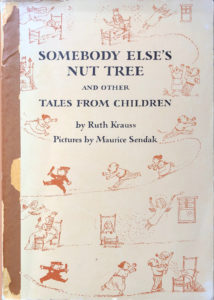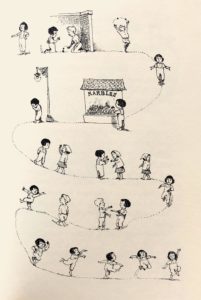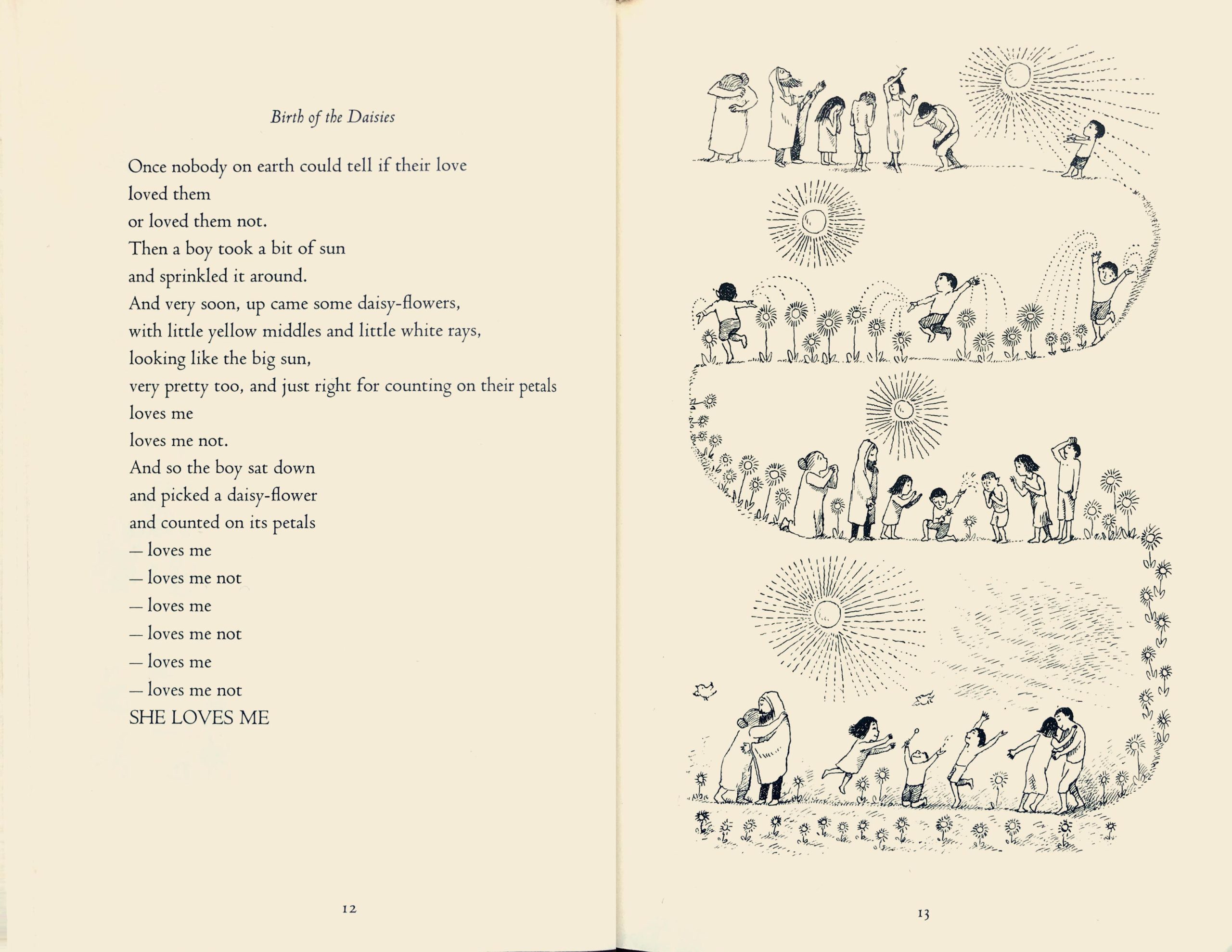I recently picked up a used copy of Somebody Else’s Nut Tree by Ruth Krauss and Maurice Sendak (Harper & Brothers, 1958) on Abebooks. It’s one of the many books Krauss and Sendak collaborated on together, as I’d discovered reading Dear Genius: The Letters of Ursula Nordstrom.
The cover of Somebody Else’s Nut Tree is a madcap, swirling dash of characters from the tales. The book’s contents are an illustrated collection of seventeen short, sometimes quotidian, sometimes mythic, children’s tales, that are poetic, brilliant and utterly bonkers.
From children hugging their mothers to rainbows cracking into happy spots that stick to houses, from lion hunts and birthday presents to Cinderella trees and happy eggs—Krauss taps into the remarkable imaginative vision of children in a way that remains fascinating throughout the forty or so pages that hold these strange tales. Her unique talent for capturing the spirit of childlike story-telling with its exaggerations, repetitions, vivid imaginings, puerile satisfactions, clichés, illogical and often absurd unravellings is refreshing and uncommon, even when read today.
On first reading, Krauss’s style also appeared to me as uniquely uninhibited by adult literary expectations.
As an example, in “A Girl at a Party” there’s a pretty girl who gets the guy and all the money, but the other girls don’t give a damn. Why? Because they have nice warm bath robes. Unless Krauss is giving a wink to kids versed in literary bathos, it appears she’s simply flouting convention and expectations—something child artists are very adept at.
Or consider “Happy Marbles!” A girl loses a marble, ends up owning two, and repeatedly sings “Happy marbles […] to all” finishing with a triumphant “Hooray! To ALL.” While it “means” almost nothing, this tale is a song of joy about the tiny triumph at its outcome—two happy marbles! Come share in the joy! Sendak does. He joins in, visually capturing the song-and-dance tone of the piece perfectly in lively, simple line-drawings.
Two other favorites are, “Birth of the Daisies” (an origin story for loves me, loves me not petal picking), which is a small masterpiece poetically and visually, and the title tale, “Somebody Else’s Nut Tree”, which closes the book. This latter is strangely affecting, partly because it says nothing of the little girl’s tears in the companion drawing when she discovers the nut tree she has found is someone else’s nut tree. It gives a sombre feel to the close of the book, and perhaps the literary insightfulness of the venerable Ursula Nordstrom was at work here; certainly, it made me want to rediscover the joy I found at the book’s beginning.
In all, Somebody Else’s Nut Tree is full of little gems and it’s worth finding a copy for your library. While it’s currently out-of-print, as far as I can tell, there are usually one or two reasonably-priced, if battered, copies available on Abebooks.
And a Surprise…
The book also contained a big surprise for me, due admittedly to my own inattentiveness. I had read Somebody Else’s Nut Tree through in its entirety before I set it down to look again at the cover. It was only then I noticed the full title of this slim little masterwork is:
SOMEBODY ELSE’S NUT TREE And Other TALES FROM CHILDREN
“Tales from Children”? I hadn’t noticed the subtitle on first reading, but an online search confirmed what it suggested: These aren’t Krauss’s stories at all! They are stories written—or told—by children that Krauss had collected, polished up, and restructured a little perhaps, but had, in essence, transcribed as they were originally shared with her.
I’d missed the subtitle and had misread the book!
And so, what to say, except it was surprising, but not disappointing, to learn this unique little tome is the work of more artists than the two credited on the cover. I’d duped myself through lack of attention but gained a new appreciation for the literary abilities of children in doing so. Put another way, I thought I’d found a nut tree, but when I went close, and climbed it, I saw it was somebody else’s nut tree.



